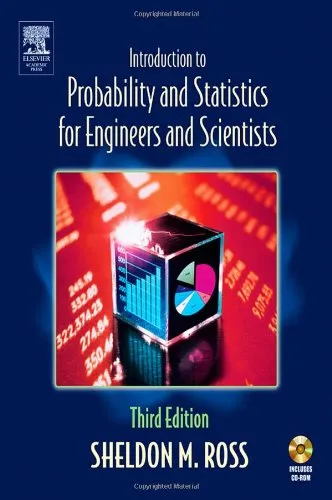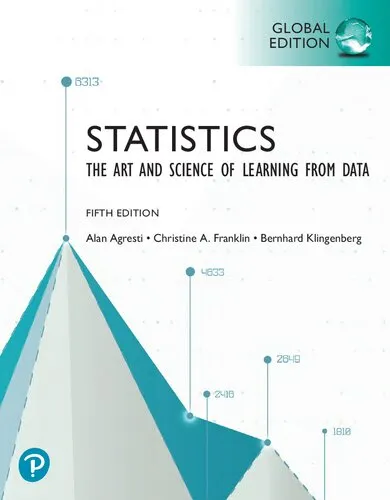Introduction to Probability and Statistics for Engineers and Scientists
4.5
Reviews from our users

You Can Ask your questions from this book's AI after Login
Each download or ask from book AI costs 2 points. To earn more free points, please visit the Points Guide Page and complete some valuable actions.Related Refrences:
Introduction to "Introduction to Probability and Statistics for Engineers and Scientists"
Sheldon M. Ross’s "Introduction to Probability and Statistics for Engineers and Scientists" serves as an essential guide for bridging the core concepts of probability and statistics with practical applications in engineering and scientific disciplines. This highly acclaimed textbook combines theoretical concepts with real-world problem-solving techniques to provide a robust learning experience for students, professionals, and enthusiasts in technical fields.
Detailed Summary of the Book
Designed to cater to both beginners and those with some background knowledge, this book is an excellent resource to start exploring the fundamentals of probability and statistics. Spanning across comprehensive topics, its focus lies on topics like probability distributions, statistical inference, regression analysis, hypothesis testing, and experimental design.
The text takes a systematic approach to guide readers through applied probability topics like random variables, expectations, and stochastic processes. Furthermore, the inclusion of core statistical principles ensures readers gain a deeper understanding of data interpretation methods, exploring confidence intervals, variance, and correlation concepts. Readers are introduced to various problem-solving techniques through an abundance of worked-out examples and chapter-end exercises that reinforce the material.
One of the standout features of the book is its emphasis on engineering and scientific applications. Whether it’s reliability analysis in manufacturing, quality control in industries, or experimental designs in research, the book ensures that the theoretical frameworks of probability and statistics are tied directly to real-world scenarios. The book also integrates recent technological advancements and approaches relevant to engineers and scientists, ensuring relevance in a constantly evolving academic and professional landscape.
Through its comprehensive yet practical approach, the book equips engineers and scientists with the necessary critical thinking skills and statistical tools to analyze and solve complex problems effectively.
Key Takeaways
- Clear and concise explanations of fundamental probability and statistical concepts.
- In-depth coverage of probability distributions, random variables, and statistical inference.
- Extensive engineering and science-focused examples that ground theoretical principles in practical applications.
- Emphasis on problem-solving with step-by-step examples and end-of-chapter exercises.
- Integration of modern computational techniques and real-world technological case studies.
- A focus on the importance of uncertainty modeling and decision-making under uncertainty.
Famous Quotes from the Book
"Probability is not about certainty but about understanding the likelihood of outcomes and preparing for the best possible decision."
"Data is not merely numbers but a story awaiting discovery; statistics is the tool we use to interpret and learn from it."
"An understanding of probability and statistics is essential for engineers and scientists to design systems and make decisions in an uncertain world."
Why This Book Matters
In today’s data-driven and technologically advanced world, having a strong foundation in probability and statistics is imperative for engineers and scientists. The ability to gather insights from data, make informed decisions, and design efficient processes under uncertain conditions is crucial across numerous industries.
"Introduction to Probability and Statistics for Engineers and Scientists" stands out for its clarity and relevance. Unlike generic textbooks, this book explicitly tailors its material toward real-world problems encountered by engineering and scientific fields. By emphasizing the practical significance of theories and techniques, the book ensures that readers are not just learning for academic purposes but are also prepared for professional challenges.
The book’s comprehensive problem sets and application-oriented approach cultivate critical thinking and analytical skills, ultimately enhancing readers’ overall competency in their respective disciplines. Whether you are designing a product, optimizing systems, or conducting experiments, the knowledge you gain from this text will influence your ability to solve problems with precision.
Sheldon M. Ross's work continues to be a cornerstone in probability and statistics education. This text is indispensable for those pursuing careers in engineering, applied sciences, operations research, and beyond. Its structured pedagogy, practical applications, and clear writing style make it an enduring resource for academic studies and professional success.
Free Direct Download
You Can Download this book after Login
Accessing books through legal platforms and public libraries not only supports the rights of authors and publishers but also contributes to the sustainability of reading culture. Before downloading, please take a moment to consider these options.
Find this book on other platforms:
WorldCat helps you find books in libraries worldwide.
See ratings, reviews, and discussions on Goodreads.
Find and buy rare or used books on AbeBooks.
1273
بازدید4.5
امتیاز50
نظر98%
رضایتReviews:
4.5
Based on 0 users review
"کیفیت چاپ عالی بود، خیلی راضیام"



